
The Battle of Amberg, fought on 24 August 1796, resulted in a Habsburg victory by Archduke Charles over a French army led by Jean-Baptiste Jourdan. This engagement marked a turning point in the Rhine campaign, which had previously seen French successes.
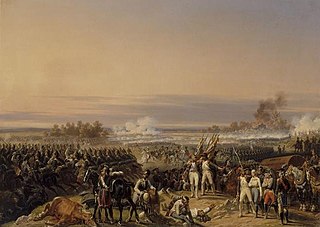
The Battle of Höchstädt was fought on 19 June 1800 on the north bank of the Danube near Höchstädt, and resulted in a French victory under General Jean Victor Marie Moreau against the Austrians under Baron Pál Kray. The Austrians were subsequently forced back into the fortress town of Ulm. Instead of attacking the heavily fortified, walled city, which would result in massive losses of personnel and time, Moreau dislodged Kray's supporting forces defending the Danube passage further east. As a line of retreat eastward disappeared, Kray quickly abandoned Ulm, and withdrew into Bavaria. This opened the Danube pathway toward Vienna.
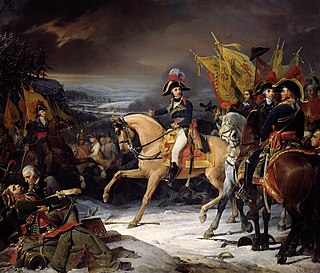
The Battle of Hohenlinden was fought on 3 December 1800 during the French Revolutionary Wars. A French army under Jean Victor Marie Moreau won a decisive victory over an Austrian and Bavarian force led by 18-year-old Archduke John of Austria. The allies were forced into a disastrous retreat that compelled them to request an armistice, effectively ending the War of the Second Coalition. Hohenlinden is 33 km east of Munich in modern Germany.
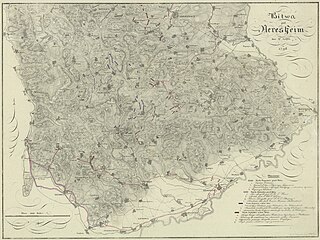
The Battle of Neresheim was fought by the Republican French army under Jean Victor Marie Moreau against the army of the Habsburg monarchy of Archduke Charles, Duke of Teschen. Pursued by Moreau's Army of Rhin-et-Moselle, Charles launched an attack against the French. While the Austrian left wing saw some success, the battle degenerated into a stalemate and the archduke withdrew further into the Electorate of Bavaria. Neresheim is located in the state of Baden-Württemberg in Germany a distance of 57 kilometres (35 mi) northeast of Ulm. The action took place during the War of the First Coalition, part of a larger conflict called the French Revolutionary Wars.

The Battles of Stockach and Engen were fought on 3 May 1800 between the army of the First French Republic under Jean Victor Marie Moreau and the army of the Habsburg monarchy led by Paul Kray. The fighting near Engen resulted in a stalemate. However, while the two main armies were engaged at Engen, Claude Lecourbe captured Stockach from its Austrian defenders. The loss of his main supply base at Stockach compelled Kray to order a retreat. Stockach is located near the northwestern end of Lake Constance while Engen is 20 kilometres (12 mi) west of Stockach. The action occurred during the War of the Second Coalition, part of the French Revolutionary Wars.
The Napoleonic Wars continued from 1799 with the French fighting the forces of the Second Coalition. Napoleon Bonaparte had returned from Egypt and taken control of the French government, marking the end of the French Revolution. He prepared a new campaign, sending Moreau to the Rhine frontier and personally going to take command in the Alps, where French forces had been driven almost out of Italy in 1799.

The Battle of Stockach occurred on 25 March 1799, when French and Austrian armies fought for control of the geographically strategic Hegau region in present-day Baden-Württemberg. In the broader military context, this battle constitutes a keystone in the first campaign in southwestern Germany during the Wars of the Second Coalition, part of the French Revolutionary Wars.

Michael von Kienmayer was an Austrian general. Kienmayer joined the army of the Habsburg monarchy and fought against the Kingdom of Prussia and Ottoman Turkey. During the French Revolutionary Wars, he continued to make his reputation in the cavalry and became a general officer. In the War of the Second Coalition and the Napoleonic Wars he commanded both divisions and corps. He was appointed Proprietor (Inhaber) of an Austrian cavalry regiment in 1802 and held this honor until his death. Later he was the governor of Galicia, Transylvania, and Moravia.

The Battle of Messkirch saw a Republican French army led by Jean Victor Marie Moreau attack a Habsburg Austrian army commanded by Paul Kray. At the start of the 1800 campaign in Germany, Moreau's 108,000-strong field army faced Kray's 120,000-man army on opposite sides of the Rhine River. By a series of maneuvers, Moreau crossed the Rhine and concentrated superior forces to defeat Kray at the Battles of Stockach and Engen on 3 May. After Kray retreated a short distance to the north, the two adversaries met again at Meßkirch. After a well-contested fight, Kray withdrew again, conceding victory to the French.
Johann Sigismund Graf von Riesch joined the army of Habsburg Austria as a cavalry officer and, during his career, fought against the Kingdom of Prussia, Ottoman Turkey, Revolutionary France, and Napoleon's French Empire. He became a general officer during the French Revolutionary Wars and held important commands during the War of the Second Coalition. He displayed a talent for leading cavalry formations, but proved less capable when given corps-sized commands. During the 1805 Ulm Campaign in the Napoleonic Wars, the French badly defeated his corps and forced it to surrender soon afterward. From 1806 to his death in 1821, he was the Proprietor (Inhaber) of an Austrian cavalry regiment.

The Battle of Ettlingen or Battle of Malsch was fought during the French Revolutionary Wars between the armies of the First French Republic and Habsburg Austria near the town of Malsch, 9 kilometres (6 mi) southwest of Ettlingen. The Austrians under Archduke Charles, Duke of Teschen tried to halt the northward advance of Jean Victor Marie Moreau's French Army of Rhin-et-Moselle along the east bank of the Rhine River. After a tough fight, the Austrian commander found that his left flank was turned. He conceded victory to the French and retreated east toward Stuttgart. Ettlingen is located 10 kilometres (6 mi) south of Karlsruhe.

At the Battle of Ampfing on 1 December 1800, Paul Grenier's two divisions of the First French Republic opposed the Austrian army southwest of the town of Ampfing during the French Revolutionary Wars. The Austrians, under the leadership of Archduke John of Austria, forced their enemies to retreat, though they sustained greater losses than the French. Ampfing is located 63 kilometers east of Munich and 8 km (5.0 mi) west of Mühldorf am Inn.

At the Battle of Emmendingen, on 19 October 1796, the French Army of Rhin-et-Moselle under Jean Victor Marie Moreau fought the First Coalition Army of the Upper Rhine commanded by Archduke Charles, Duke of Teschen. Emmendingen is located on the Elz River in Baden-Württemberg, Germany, 9 miles (14 km) north of Freiburg im Breisgau. The action occurred during the War of the First Coalition, the first phase of the larger French Revolutionary Wars.

The Battle of Biberach was fought on 2 October 1796 between a French Republican army led by Jean Victor Marie Moreau and a Habsburg Austrian army led by Maximilian Anton Karl, Count Baillet de Latour. The French army paused in its retreat toward the Rhine River to maul the pursuing Austrians. The action occurred during the War of the First Coalition, part of the French Revolutionary Wars.

The Battle of Biberach on 9 May 1800 saw a French First Republic corps under Laurent Gouvion Saint-Cyr engage part of a Habsburg Austrian army led by Pál Kray. After an engagement in which the Austrians suffered twice as many casualties as the French, Kray withdrew to the east. The combat occurred during the War of the Second Coalition, part of the French Revolutionary Wars. Biberach an der Riss is located 35 kilometres (22 mi) southwest of Ulm.

In the Rhine campaign of 1796, two First Coalition armies under the overall command of Archduke Charles outmaneuvered and defeated two French Republican armies. This was the last campaign of the War of the First Coalition, part of the French Revolutionary Wars.
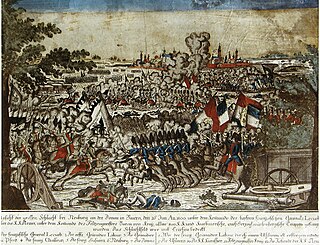
The Battle of Neuburg occurred on 27 June 1800 in the south German state of Bavaria, on the southern bank of the Danube river. Neuburg is located on the Danube between Ingolstadt and Donauwörth. This battle occurred late in the War of the Second Coalition (1798–1802), the second war between Revolutionary France and the conservative European monarchies, which included at one time or another Britain, Habsburg Austria, Russia, the Ottoman Empire (Turkey), Portugal and Naples. After a series of reverses, several of the allies withdrew from the Coalition. By 1800, Napoleon's military victories in northern Italy challenged Habsburg supremacy there. French victories in the upper Danubian territories opened a route along that river to Vienna.

Antoine Digonet commanded a French brigade during the French Revolutionary Wars and Napoleonic Wars. He joined the French Royal Army and fought in the American Revolutionary War as a foot soldier. In 1792 he was appointed officer of a volunteer battalion. He fought the Spanish in the War of the Pyrenees and was promoted to general officer. Later he was transferred to fight French royalists in the War in the Vendée. In 1800 he was assigned to the Army of the Rhine and led a brigade at Stockach, Messkirch and Biberach. Shortly after, he was transferred to Italy. In 1805 he fought under André Masséna at Caldiero. He participated in the 1806 Invasion of Naples and led his troops against the British at Maida where his brigade put up a sturdy resistance. After briefly serving in the 1809 war, he took command of Modena and died there of illness in 1811. He never married.

Ludwig Wilhelm Anton, Count Baillet de Latour-Merlemont served as an Austrian general during the French Revolutionary Wars. From a noble family, he joined the Austrian army as a volunteer in 1767 and fought in the War of the Bavarian Succession as a commissioned officer. He was promoted to command an infantry regiment in 1788 and fought in the Austro-Turkish War. He became a Generalmajor in 1794 during the War of the First Coalition against France. He fought in the Rhine campaign of 1795 and led a division in numerous battles during the Rhine campaign of 1796. He was known as Count Baillet or Count Baillet-Merlemont to distinguish him from his higher-ranking older brother Maximilian Anton Karl, Count Baillet de Latour. He was promoted Feldmarschall-Leutnant in 1797.
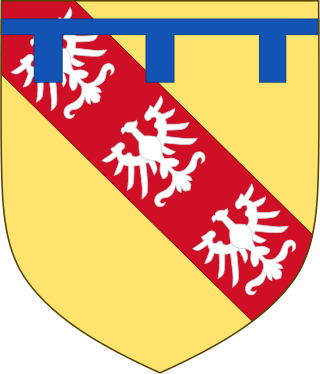
Joseph Maria Louis, Prince of Lorraine-Vaudémont served as an Austrian general during the French Revolutionary Wars. Born into a noble family in France, he went into exile in 1791 during the French Revolution and offered his services to the Habsburg monarchy. He fought in the Austrian army during the War of the First Coalition, rising in rank from leading a cavalry regiment to commanding a brigade. He led a division during the War of the Second Coalition and the War of the Third Coalition. He died in Hungary in 1812.























